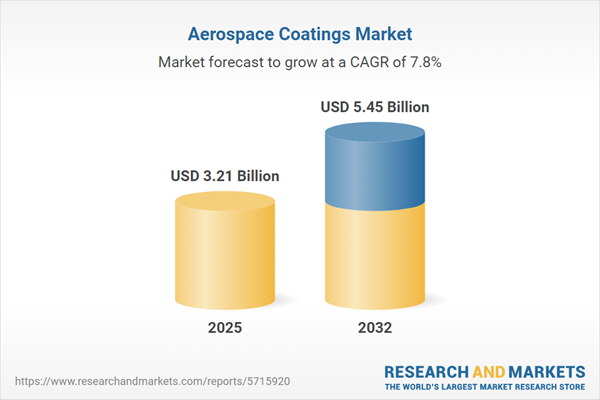Speak directly to the analyst to clarify any post sales queries you may have.
The aerospace coatings market is evolving rapidly as regulatory demands tighten and sustainability becomes a top priority for aviation stakeholders. Senior executives increasingly seek forward-looking insights to guide strategy amid new compliance challenges, rising environmental expectations, and a shift toward advanced technology adoption in aerospace coatings.
Market Snapshot: Outlook and Expansion Across the Aerospace Coatings Market
Valued at USD 2.97 billion in 2024, the aerospace coatings market is experiencing stable growth fueled by regulatory changes, greater integration of advanced materials, and industry-wide sustainability initiatives. Expansion is projected to continue, with forecasts indicating a compound annual growth rate (CAGR) of 7.84% through 2032. Commercial and defense aviation drive expanding applications of innovative coatings, supporting operational demands for reliability and strict compliance. Stakeholders across the market are increasingly favoring environmentally responsible solutions, responding to shifting operational requirements and customer priorities. The market’s forward momentum is further supported by regulatory agencies advocating for cleaner and safer coating technologies, bolstering global adoption of next-generation products throughout the aerospace industry.
Aerospace Coatings Market: Scope & Segmentation
This comprehensive market report is structured to inform leaders in procurement, manufacturing, and operations, enabling clear, data-driven decisions in a competitive sector. Key scope and segmentation highlights:
- Resin Types: Acrylic, epoxy, polyurethane, and waterborne resins, selected for their compliance capabilities and durability in aerospace conditions.
- Applications: Solutions encompass anti-corrosion, decorative finishing, fire resistance, abrasion protection, anti-icing, intumescent, electrical conductivity, ceramics, and thermal barriers, supporting performance and operational safety.
- End Uses: Offerings span original equipment installation, as well as maintenance, repair, and overhaul, ensuring comprehensive lifecycle management for both fixed-wing and rotary aircraft.
- Technologies: Powder coatings, solvent-borne, UV-curable, and waterborne formulations enable efficient manufacturing, enhanced compliance, and responsible production practices.
- Aircraft Platforms: Tailored coatings address needs across commercial airlines, business jets, general aviation, military aircraft, and unmanned aerial vehicles.
- Product Forms: Available in aerosol, liquid, and powder formats, providing options for integration into varied manufacturing and maintenance workflows and ensuring supply chain flexibility.
- Regions: Coverage includes the Americas, Europe, Middle East & Africa, and Asia-Pacific, recognizing distinct regulatory environments and adoption patterns for coatings technology.
- Leading Companies: Market assessment focuses on major players such as PPG Industries, Akzo Nobel, Axalta, Sherwin-Williams, Hempel, Mankiewicz, Jotun, Kansai Paint, RPM International, and Nippon Paint, with analysis of their innovation and market positioning strategies.
Key Takeaways: Strategic Insights for Decision-Makers
- Leading resin and coating advancements are supporting lighter-weight aircraft and improved fuel performance while facilitating compliance with evolving environmental standards.
- Effective partnerships between suppliers and OEMs foster agile maintenance programs and faster adaptation to shifting regulatory landscapes, minimizing operational downtimes through optimized coating applications.
- The integration of digitalization and automation in coatings application is enhancing consistency and quality, supporting operational reliability for globally distributed fleets.
- Localized product development and supply adaptability help address varying compliance demands, optimizing protection and operational integrity across distinct geographic regions.
- Strengthening regional supplier networks is proving essential for mitigating supply chain interruptions, allowing aerospace organizations to advance continuity and manage global sourcing risks.
- Regions that prioritize environmental regulations and ESG commitments are more actively adopting UV-curable and waterborne technologies to support compliance and sustainability outcomes.
Tariff Impact: Navigating U.S. Trade Changes in 2025
Newly anticipated tariff adjustments in the United States for 2025 are prompting aerospace coatings providers to shift procurement strategies, including a focus on increasing domestic production and developing robust local supplier networks. These preemptive actions are designed to improve market predictability, bolster resilience, and mitigate risks associated with global trade. Early and strategic adaptation positions U.S.-based companies to retain competitiveness and business certainty under evolving regulatory conditions.
Methodology & Data Sources
Analysis for this report is based on direct interviews with aerospace coatings manufacturers, OEMs, and MRO professionals, validated through comprehensive secondary research and expert panel reviews. This approach ensures findings accurately reflect real-time industry dynamics and provide relevant recommendations for leadership.
Why This Report Matters
- Gives senior decision-makers actionable insights to optimize procurement and compliance processes in response to evolving sector demands.
- Enables adoption of innovative technologies and informs capital investment, supporting long-term operational value in aerospace coatings.
- Helps operations managers secure dependable supply chains while extending asset life cycles through strategic coatings selection.
Conclusion
This market report delivers actionable guidance, supporting senior leaders as they anticipate shifting industry priorities and embed resilience in their procurement and operations strategies.
Additional Product Information:
- Purchase of this report includes 1 year online access with quarterly updates.
- This report can be updated on request. Please contact our Customer Experience team using the Ask a Question widget on our website.
Table of Contents
3. Executive Summary
4. Market Overview
7. Cumulative Impact of Artificial Intelligence 2025
Companies Mentioned
The companies profiled in this Aerospace Coatings market report include:- PPG Industries, Inc.
- Akzo Nobel N.V.
- Axalta Coating Systems Ltd.
- The Sherwin-Williams Company
- Hempel A/S
- Mankiewicz Gebr. & Co. GmbH & Co. KG
- Jotun A/S
- Kansai Paint Co., Ltd.
- RPM International Inc.
- Nippon Paint Holdings Co., Ltd.
Table Information
| Report Attribute | Details |
|---|---|
| No. of Pages | 199 |
| Published | October 2025 |
| Forecast Period | 2025 - 2032 |
| Estimated Market Value ( USD | $ 3.21 Billion |
| Forecasted Market Value ( USD | $ 5.45 Billion |
| Compound Annual Growth Rate | 7.8% |
| Regions Covered | Global |
| No. of Companies Mentioned | 11 |









